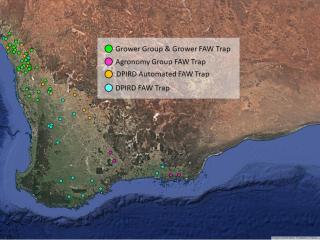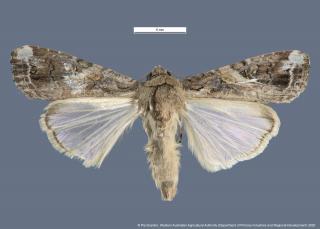Fall armyworm detected in the WA grainbelt
- Moonyoonooka

The Department of Primary Industries and Regional Development (DPIRD) has teamed up with growers, grower groups and agronomists to get the heads up on fall armyworm (FAW) moths moving into the grainbelt. A total of 70 sites are being monitored for the moth using a trap with a pheromone lure specific to the FAW species, Spodoptera frugiperda.
Last week, a single male FAW moth was detected in a DPIRD trap at Moonyanooka, just east of Geraldton.
The other traps are not recording any moths, and there have been no reports of FAW caterpillars or crop damage to date.
This follows Australia’s first detection of the invasive pest from northern Queensland in February 2020 through to Darwin, Kununurra, Broome and down to Carnarvon.
Senior research scientist Helen Spafford (DPIRD) says vegetable and grain growers in the area should be checking for larvae in their crops, monitor unusual levels of damage, and report suspected FAW to the department to assist with surveillance and potential management options.
Chemical permits
The Australian Pesticide and Veterinary Medicine Authority (APVMA) has issued a number of permits for the use of certain chemicals for the control of fall armyworm, and is currently assessing, as a priority, additional applications for permits for the use of chemicals against fall armyworm.
For information on permits for fall armyworm in cereals, pulses and canola, see DPIRD’s Fall armyworm management in grain crops page.
For a complete list of permits for all crops refer to APVMA’s Permits search page.
What should you do if you suspect you have found FAW?
There have been reports of other caterpillar activity in the grainbelt of WA, especially native budworm, Helicoverpa punctigera. It is important that caterpillars are correctly identified to assist with management decisions.
To have your caterpillars identified by DPIRD entomologists take clear close-up photos of the caterpillar and plant damage and submit a report using the MyPestGuide Reporter app or contact DPIRD’s Pest and Disease Information Service (PaDIS) by email or phone +61 (0)8 9368 3080.
For more information on FAW refer to DPIRD’s;
- Fall Armyworm in Western Australia page
- How to identify fall armyworm video.
- 2020 PestFax Issue 4 article Fall armyworm management advice for broadacre crops is available online
For more information contact Dustin Severtson, Research scientist, Northam on +61 (0)427 196 656 or Alan Lord, Technical Officer, South Perth on +61 (0)409 689 468 or Svetlana Micic, Research Scientist, Albany on +61 (0)427 772 051.
Article author: Dustin Severtson (DPIRD Northam).

